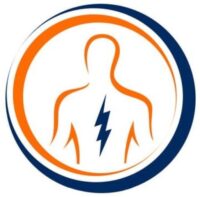Today, in this article we are going to discuss lumbago or low back pain treatment in detail. Lumbago or low back pain is a very common problem nowadays. 80% of the population goes through this at least once in their life. We have already discussed its causes, clinical features, examination, and prevention in detail in our previous article.
Read More: Lumbago causes, features, and prevention.
TREATMENT OF LUMBAGO
PRINCIPLES:
The principles of treating lumbago or lower back pain are:
- Relieve pain in acute cases
- Restore normal movements in chronic cases
- Prevention of recurrence
A patient who is suffering from back pain needs a multi-prolonged approach to successfully combat the causative factors and relieve the patient from pain. The various treatment options are:
1. Bed Rest
The intradiscal pressure is the lowest when the patient is supine. It increases 3 times during standing and 11 times during sitting. This is the reason for suggesting bed rest for patients suffering from lumbago.
TYPES:
- Semifowler’s positions: In this position, both the hip and knee of the patient are in a flex position. This is a very comfortable position, as it relieves stress on the back.
- Supine lying with pillows beneath the knees also relieves pain.
- Side-lying with hip and knee in flexion is also effective.
CAUTION: Prone lying is hazardous and one should not attain it at all costs.
2. Cryotherapy
It is useful during acute low back pain, as it reduces pain, swelling, and muscle spasm. It also reduces the local metabolic activity and delays nerve conduction.
- Cold packs: They are useful in the initial stages, during the first 24-48 hours, and are very effective.
- Ice massage: Ice is applied along the course of the muscle fibers.
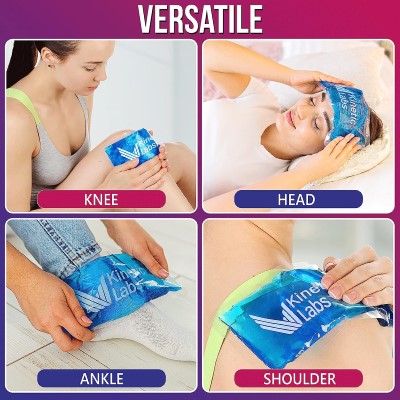
3. Thermotherapy
Heat causes vasodilation thereby reducing muscle ischemia. This reduces the pain and relieves the muscle spasm. It also acts through counter-irritation.
SUPERFICIAL HEAT: It is given through hydrocollator packs, infrared rays, and heating pads.
The heat generated by these reaches only up to the level of subcutaneous tissue.
DEEP HEAT: The two common modes of deep heat therapy are ultrasound and short-wave diathermy. These two heat the structure below the subcutaneous tissue.
- Short wave diathermy: It heats deeper structures like muscles, ligaments, and bones. There are two modes in SWD, one is continuous (useful in chronic low back pain) and the other is the pulsed mode (useful during acute pain).
- Ultrasound: This penetrates deeper than SWD. Though it is useful for both acute and chronic pains, its use in acute conditions is not much use as it causes vasodilation.
Usage: Treatment for about 20 minutes 3 times a week for 3-4 weeks. Another advantage of the US is it helps to drive medicines like Xylocaine, analgesic cream, and hydrocortisone deeper into the tissues. It also increases the stretchability of the joint capsules and ligaments.
4. TENS
Tens are effective in both acute and chronic pains.
Mode: 2-4 Hz at 50 MA pulse rate at 2 pulse/sec between 30-60 minutes pulse width.
5. Traction
Traction as a form of treatment for low backache followed for ages. It is the most popular method of management of LBA.
HOW DOES TRACTION HELP?
- Stretches the spinal muscles and ligaments and hence reduces the intradiscal pressure.
- By distracting the vertebral body and the facet joints.
- Widens the intervertebral foramen, and relieves pressure on the nerve roots.
TYPES OF SPINAL TRACTION:
- Continuous traction: In this, light weights are applied for several hours a day. This method has its own drawback that it is difficult for the patient to tolerate the weight for a very long time.
- Sustained traction: This needs a steady amount of weight and is applied for a period of 30 minutes. The patient is able to tolerate heavy weights for a short period of time.
- Intermittent traction: It is the most popular method of traction. Here through a mechanical device, weight is applied and released for a short period of time.
- Manual traction: Here the physiotherapist applies the traction force manually. Not a very popular method, since the patient is unable to anticipate the amount of traction force.
- Positional traction: It is useful to stretch one side of the spine.
- Autotraction: Here the patient himself generates traction by pulling on a cord attached to a pelvic waist.
- Gravity traction: Here patient is suspended vertically or lies in an inverted position. Here the force of gravity stretches the spinal structures.
INDICATIONS OF TRACTION:
- Disk protrusion
- Lumbar spondylosis
- Spondylolisthesis
- Sciatic scoliosis, etc.
CONTRAINDICATIONS OF TRACTION:
- Infective spine diseases
- Malignancy
- Acute strains and sprains
- Massive disk prolapse
- Pain during rest
- Cardiac problems
6. Corsets and Braces
More than 99% of orthopedists use corsets and braces during the treatment of lumbago.
HOW DO THEY ACT?
- They increase the intra-abdominal pressure and the force is diverted against the diaphragm and thoracic spine. This reduces the load on the lumbar spine.
- Some of the load will transmit to the oblique and transverse abdominal muscles.
- It provides a sense of security to the back.
- It provides a natural splint to the spine.
- Corrects the faulty posture.
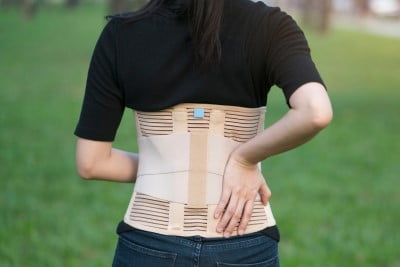
ADVANTAGES OF CORSET/BRACE:
- It helps the patient to recover the mobility of the spine faster.
- Acts as additional support when patients return to heavy labor.
- Braces are useful in excessively obese patients with weak abdominals.
- Helpful for elderly patients who cannot tolerate exercise.
- Very useful in patients with scoliosis.
- Provides a sense of security.
DISADVANTAGES OF BRACES:
Immobilization leads to muscle atrophy leading to weakness in the spinal musculature.
INDICATIONS OF CORSETS/BRACES:
- Acute disk disease
- Spondylolisthesis
- Post-spinal surgery
7. Manipulation
Spinal manipulations are a skilled technique to be done by a trained person in a gentle manner. Manual force brings about passive movements either within or beyond the active range of motion.
PRINCIPLES OF MANIPULATION:
It is based on the principle that vertebral malalignment is the cause of low backache and it sets this alignment.
BENEFITS OF MANIPULATION:
- It sets right the vertebral malposition.
- Relieves muscle spasms.
- Reduction of the prolapsed disk by freeing the adhesions around the prolapsed disk.
- Stimulates the alpha fibers and blocks nociceptive inputs of pain fibers.
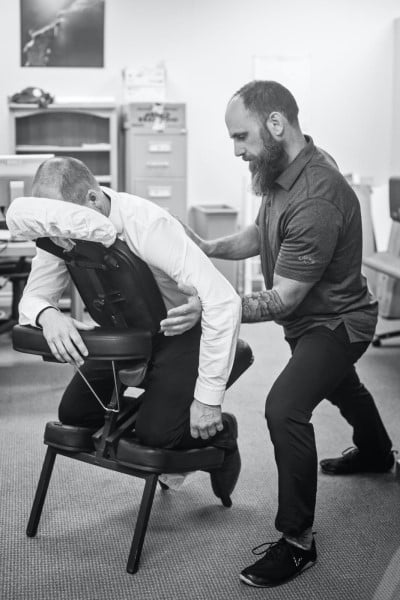
TECHNIQUES:
- Stretch technique: Useful in joints with contract capsules.
- Thrust technique: Useful in joints that exhibit hard stops in one direction.
- Oscillation technique: Employed in the recently injured joint.
- Rotation and side body technique: Used in facet joint locking or restorations.
8. Massage
Massage helps by stimulating the tissues and thus relaxes the contracted muscles.
MECHANISM OF ACTION:
- Relaxation of contracted muscles.
- Increases the blood circulation to the area.
- Counter irritation and release of endorphins.
- Psychological boost to the patient.
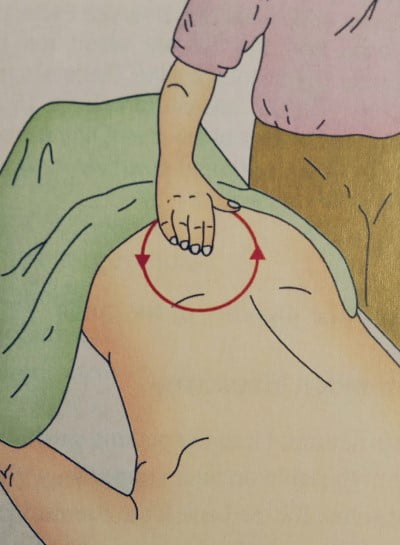
9. Exercises for Lumbago
The exercises for lumbago can be flexion, extension, and rotational exercises. Exercises should not be ‘generalized’ but should be ‘individualized’ depending upon the patients.
HOW DOES EXERCISE BENEFIT LUMBAGO PATIENTS?
- It reduces pain.
- Stretches the contracted muscles, ligaments, and capsules.
- Improves spinal mobility.
- Improves posture.
- Stabilizes the hypermobile joints.
- Reduces the mechanical stress on spinal structures.
- Strengthens the weak muscles.
- Relieve depression and anxiety.
- Improves nutrition to joints and disks.
- Improves neuromuscular control and coordination.
Before we begin with exercises for lumbago, must remember these points:
- Each exercise should be done one to five times twice a day.
- The number of repetitions should be kept increasing to reach a minimum of 10 repetitions twice daily.
- Exercises are to be done slowly and smoothly.
CHOICE OF EXERCISES:
A correct choice whether flexion or extension exercises should depend upon the following indications below:
Flexion Exercises
If pain relieves on:
- Sitting
- Forward bending
- Lumbar lordosis
- Fixed lumbar lordosis with bending
If pain increases on:
- Walking
- Standing
- Sustained forward bending
- Repeated backward bending.
- The extreme range of backward bending.
Pain unchanged on:
- Stooping
Extension Exercises
If pain relieves on:
- Lying
- Walking
- Repeated back bending
- Decreases lumbar lordosis
If pain increases on:
- Sitting
- Driving
- Arising from chair
- Stooping
- Bending
- Forward bending
- Repeated forward bending
Flexion exercises
Flexion exercises are useful in achieving the following goals:
- To open the intervertebral foramina
- To unlock the facet joints
- Stretch the hip flexors
- To strengthen the abdominal muscles
- To stretch the back extensors
- Increase the intra-abdominal pressure.
CONTRAINDICATIONS FOR FLEXION EXERCISES:
- Acute disk prolapse
- Immediately after prolonged rest with hyper hydrated disks which cause rupture.
- Postural lumbago due to flexion
- Lateral trunk shift
TYPES OF FLEXION EXERCISES FOR LUMBAGO
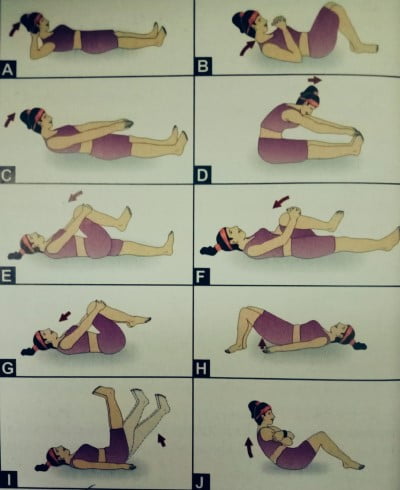
I) Anterior abdominal wall strengthening exercises (upper abdominal muscles). Exercises from A to D:
(A) In the supine position, with knees in extension. The head is supported at the back by both the hands, raise the head and neck and count to 10.
(B) Raise the head and neck, with both knees bent and the hands in front of the chest.
(C) Repeat the above exercise keeping both the hands straight.
(D) Continuing exercise C, touch the toes with both the hands.
II) Erector spinae stretching exercises (E, F, and G):
(E) In the supine position, pull the right thigh and later the left thigh.
(F) In the supine position, pull the right thigh over the abdomen and hold for 10-15 seconds.
(G) Here, pull both the hips up towards the chest. Hold for 15 seconds.
III) Exercises for strengthening the lower abdominal muscles (H, I, & J)
(H) Patient is supine, feet flat, arms by the sides. Both hips are raised from the floor and held for 10-15 seconds.
(I) Patient is supine. Bilateral straight leg raising exercises at 30, 60, and 90 degrees are performed for 15 seconds each.
(J) With the arms in front of the chest, knees bent and feet flat on the floor, the patient raises the head, neck, and chest forwards. Exercises both upper and lower abdominal muscles.
EXTENSION EXERCISES
- These exercises aim to achieve the following goals.
- They maintain the normal lumbar lordosis.
- They improve the strength of the extensor muscles of the back and the hip.
- In patients with posterior or posterolateral disk prolapse, it helps to relieve the pressure on the disks.
- They improve the mobility of the spine.
CONTRAINDICATIONS FOR EXTENSION EXERCISES:
- Multiple back operations.
- Spinal stenosis
- Spondylolisthesis
- Acute disk prolapse
TYPES OF EXTENSION EXERCISES:
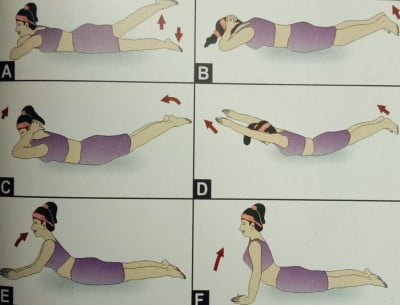
(A) Patient is prone, both the arms are folded under the chin. While keeping the knees straight, lift the legs alternatively and count to 10.
(B) The patient is prone and hands tucked behind the head. Then both the legs are lifted straight for a count of ten.
(C) Patient is in the same position as in B but lifts the head, neck, and legs simultaneously.
(D) The same exercise is repeated but keeping both the arms straight and lifting up.
(E, F) Prone lumbar extension exercise. Here the patient is prone. Both the hands are placed at the level of the shoulders. Gradually the upper body is pushed off the ground by straightening the arms. The hip should be placed firmly on the ground during this exercise.
ROTATIONAL EXERCISES
- These exercises provide overall relaxation of the spinal muscles.
- The external and internal oblique abdominal muscles help in the development of intra-abdominal pressure. They also help in the maintenance of anterior and posterior trunk balance. They also provide anterior stability to the spine.
The patient lies on the back, keeping the back flat and feet together. Then the knees are rotated on either side for a count of ten.
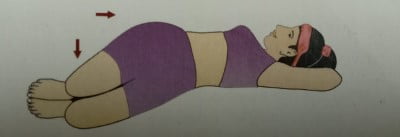
Do’s & Don’ts To Prevent Recurrence
Do’s
- Forward bent attitude
- Bodyweight bearing on the heels
- Proper weight lifting
- Sit with buttocks turned under
- While driving push the seat forwards to raise the knees and decrease the lordosis
- Flex the knees and hips when lying on the sides
- Turn on the side and then get up.
Don’ts
- Sleep in the prone position.
- Rise from the sitting position suddenly.
- Bend over a washbasin.
- Wear high heels as pelvis is thrust forward and the spine bends backward.
- Use too high chair.
- Use soft mattress which increases the lumbosacral extension. A firm mattress encourages lumbar spine to be straight.
Conclusion:
Today, in this article, we discussed the detailed treatment of lumbago along with exercises. These exercises are very beneficial for treating low backache and should be done slowly and smoothly. We have also discussed do’s and don’ts to prevent the recurrence of back pain.
ALL THE BEST!
